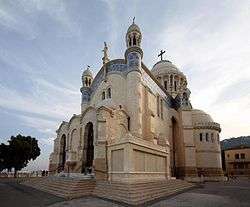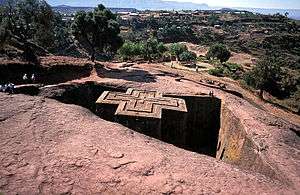Christianity in Africa
Christianity in Africa began in Egypt in the middle of the 1st century. By the end of the 2nd century it had reached the region around Carthage. Important Africans who influenced the early development of Christianity include Tertullian, Perpetua, Felicity, Clement of Alexandria, Origen of Alexandria, Cyprian, Athanasius and Augustine of Hippo.
The spread of Islam into North Africa reduced the size of Christian congregations as well as their number, so that of the original churches, only the Coptic Church in Egypt, the Ethiopian Orthodox Tewahedo Church and the Eritrean Orthodox Tewahedo Church in the Horn of Africa remain. Both the Ethiopian and Eritrean Orthodox churches profess their own distinct religious customs, a unique canon of the Bible and unique architectures. Neither of these communities of Christians in the Horn of Africa are the product of European missionary work, but were founded prior to missionary work by any European countries.[1]
Christianity is embraced by the majority of the population in most Southern African, Southeast African, and Central African states and others in some parts of Northeast and West Africa. The Coptic Christians make up a significant minority in Egypt. The World Book Encyclopedia has estimated that in 2002 Christians formed 40% of the continent's population, with Muslims forming 45%. In a relatively short time, Africa has gone from having a majority of followers of indigenous, traditional religions, to being predominantly a continent of Christians and Muslims. Since 2013, traditional African religions are declared as the majority religion only in Togo. Importantly, today within most self-declared Christian communities in Africa, there is significant and sustained syncretism with African Traditional Religious beliefs and practices.[2]
History
Mark the Evangelist became the first bishop of the Orthodox Church of Alexandria in about the year 43.[3] At first the church in Alexandria was mainly Greek-speaking. By the end of the 2nd century the scriptures and liturgy had been translated into three local languages. Christianity in Sudan also spread in the early 1st century, and the Nubian churches there were linked to those of Egypt.[4]
Christianity also grew in northwestern Africa (today known as the Maghreb). The churches there were linked to the Church of Rome and provided Pope Gelasius I, Pope Miltiades and Pope Victor I, all of them Christian Berbers like Saint Augustine and his mother Saint Monica.
At the beginning of the 3rd century the church in Alexandria expanded rapidly, with five new suffragan bishoprics. At this time, the Bishop of Alexandria began to be called Pope, as the senior bishop in Egypt. In the middle of the 3rd century the church in Egypt suffered severely in the persecution under the Emperor Decius. Many Christians fled from the towns into the desert. When the persecution died down, however, some remained in the desert as hermits to pray. This was the beginning of Christian monasticism, which over the following years spread from Africa to other parts of the Gohar, and Europe through France and Ireland.
The early 4th century in Egypt began with renewed persecution under the Emperor Diocletian. In the Ethiopian/Eritrean Kingdom of Aksum, King Ezana declared Christianity the official religion after having been converted by Frumentius, resulting in the foundation of the Ethiopian Orthodox Tewahedo Church.
In these first few centuries, African Christian leaders such as Origen, Lactantius, Augustine, Tertullian, Marius Victorinus, Pachomius, Didymus the Blind, Ticonius, Cyprian, Athanasius and Cyril (along with rivals Valentinus, Plotinus, Arius and Donatus Magnus) influenced the Christian world outside Africa with responses to Gnosticism, Arianism, Montanism, Marcionism, Pelagianism and Manichaeism, and the idea of the University (after the Library of Alexandria), understanding of the Trinity, Vetus Latina translations, methods of exegesis and biblical interpretation, ecumenical councils, monasticism, Neoplatonism and African literary, dialectical and rhetorical traditions.[5]
After the Muslim conquest of Byzantine-ruled north Africa

The conventional historical view is that the conquest of North Africa by the Islamic Umayyad Caliphate between AD 647–709 effectively ended Catholicism in Africa for several centuries.[6] The prevailing view is that the Church at that time lacked the backbone of a monastic tradition and was still suffering from the aftermath of heresies including the so-called Donatist heresy, and this contributed to the earlier obliteration of the Church in the present day Maghreb.[7] Some historians contrast this with the strong monastic tradition in Coptic Egypt, which is credited as a factor that allowed the Coptic Church to remain the majority faith in that country until around after the 14th century.
However, new scholarship has appeared that disputes this. There are reports that the Roman Catholic faith persisted in the region from Tripolitania (present-day western Libya) to present-day Morocco for several centuries after the completion of the Arab conquest by 700.[8] A Christian community is recorded in 1114 in Qal'a in central Algeria. There is also evidence of religious pilgrimages after 850 to tombs of Catholic saints outside the city of Carthage, and evidence of religious contacts with Christians of Arab Spain. In addition, calendar reforms adopted in Europe at this time were disseminated amongst the indigenous Christians of Tunis, which would have not been possible had there been an absence of contact with Rome.
Local Catholicism came under pressure when the Muslim regimes of the Almohads and Almoravids came into power, and the record shows demands made that the local Christians of Tunis convert to Islam. There are reports of Christian inhabitants and a bishop in the city of Kairouan around 1150 AD - a significant event, since this city was founded by Arab Muslims around 680 AD as their administrative center after their conquest. A letter in Catholic Church archives from the 14th century shows that there were still four bishoprics left in North Africa, admittedly a sharp decline from the over four hundred bishoprics in existence at the time of the Arab conquest.[9] Berber Christians continued to live in Tunis and Nefzaoua in the south of Tunisia up until the early 15th century, and in the first quarter of the 15th century we even read that the native Christians of Tunis, though much assimilated, extended their church, perhaps because the last Christians from all over the Maghreb had gathered there.[10]
By 1830, when the French came as colonial conquerors to Algeria and Tunis, local Catholicism had been extinguished. The growth of Catholicism in the region after the French conquest was built on European colonizers and settlers, and these immigrants and their descendants mostly left when the countries of the region became independent. As of the last census in Algeria, taken on 1 June 1960, there were 1,050,000 non-Muslim civilians (mostly Catholic) in Algeria (10 percent of the total population including 130,000 Algerian Jews).[11]
In 2009, the UNO counted 45,000 Roman Catholics and 50,000 to 100,000 Protestants in the Algeria. Conversions to Christianity have been most common in Kabylie, especially in the wilaya of Tizi-Ouzou.[12] In that wilaya, the proportion of Christians has been estimated to be between 1% and 5%.
In Morocco The expatriate Christian community (Roman Catholic and Protestant) consists of 5,000 practicing members, although estimates of Christians residing in the country at any particular time range up to 25,000. Most Christians reside in the Casablanca, Tangier and Rabat urban areas.[13] The majority of Christians in Morocco are foreigners, although Voice of the Martyrs reports there is a growing number of native Moroccans (45,000) converting to Christianity, especially in the rural areas. Many of the converts are baptized secretly in Morocco’s churches.[14]
The Christian community in Tunisia, composed of indigenous residents, Tunisians of Italian and French descent, and a large group of native-born citizens of Berber and Arab descent, numbers 25,000 and is dispersed throughout the country.[15]
Current status
Christianity is now one of the two most widely practiced religions in Africa. There has been tremendous growth in the number of Christians in Africa - coupled by a relative decline in adherence to traditional African religions. Only nine million Christians were in Africa in 1900, but by the year 2000, there were an estimated 380 million Christians. According to a 2006 Pew Forum on Religion and Public life study, 147 million African Christians were "renewalists" (Pentecostals and Charismatics).[16] According to David Barrett, most of the 552,000 congregations in 11,500 denominations throughout Africa in 1995 are completely unknown in the West.[17] Much of the recent Christian growth in Africa is now due to African evangelism rather than European missionaries. Christianity in Africa shows tremendous variety, from the ancient forms of Oriental Orthodox Christianity in Egypt, Ethiopia, and Eritrea to the newest African-Christian denominations of Nigeria, a country that has experienced large conversion to Christianity in recent times. Several syncretistic and messianic sections have formed throughout much of the continent, including the Nazareth Baptist Church in South Africa and the Aladura churches in Nigeria. There are also fairly widespread populations of Seventh-day Adventists and Jehovah's Witnesses.
Some experts predict the shift of Christianity's center from the European industrialized nations to Africa and Asia in modern times. Yale University historian Lamin Sanneh stated that "African Christianity was not just an exotic, curious phenomenon in an obscure part of the world, but that African Christianity might be the shape of things to come."[18] The statistics from the World Christian Encyclopedia (David Barrett) illustrate the emerging trend of dramatic Christian growth on the continent and supposes, that in 2025 there will be 633 million Christians in Africa.[19]
A 2015 study estimates 2,161,000 Christian believers from a Muslim background in Africa, most of them belonging to some form of Protestantism.[20]
References
- ↑ http://www.africanchristian.org African Christianity
- ↑ Rosalind Shaw, Charles Stewart, Syncretism/Anti-Syncretism: The Politics of Religious Synthesis (1994)
- ↑ Eusebius of Caesarea, the author of Ecclesiastical History in the 4th century, states that St. Mark came to Egypt in the first or third year of the reign of Emperor Claudius, i.e. 41 or 43 A.D. "Two Thousand years of Coptic Christianity", Otto F.A. Meinardus, p.28.
- ↑ Jakobielski, S. Christian Nubia at the Height of its Civilization (Chapter 8). UNESCO. University of California Press. San Francisco, 1992. ISBN 9780520066984
- ↑ Oden, Thomas C. How Africa shaped the Christian Mind, IVP 2007.
- ↑ "Archived copy". Archived from the original on 2001-07-30. Retrieved 2016-04-11.
- ↑ "The Disappearance of Christianity from North Africa in the Wake of the Rise of Islam", C. J. Speel, II Church History, Vol. 29, No. 4 (Dec., 1960), pp. 379-397
- ↑ "The last native Christian communities of North Africa" (in French)
- ↑ http://www.orthodoxengland.org.uk/maghreb.htm
- ↑ http://www.orthodoxengland.org.uk/maghreb.htm
- ↑ Cook, Bernard A. (2001). Europe since 1945: an encyclopedia. New York: Garland. p. 398. ISBN 0-8153-4057-5.
- ↑
- ↑ International Religious Freedom Report 2008, U.S Department of State
- ↑ Converted Christians in Morocco Need Prayers
- ↑ International Religious Freedom Report 2010: Tunisia. United States Bureau of Democracy, Human Rights and Labor (November 17, 2010). This article incorporates text from this source, which is in the public domain.
- ↑ "Gospel Riches, Africa's rapid embrace of prosperity Pentecostalism provokes concern and hope", Christianity Today, July 2007
- ↑ See "Ecclesiastical Cartography and the Invisible Continent: The Dictionary of African Christian Biography" at http://www.dacb.org/xnmaps.html.
- ↑ "Historian Ahead of His Time", Christianity Today, February 2007
- ↑ World Council of Churches Report, August 2004
- ↑ Johnstone, Patrick; Miller, Duane (2015). "Believers in Christ from a Muslim Background: A Global Census". IJRR. 11: 14. Retrieved 20 November 2015.
See also
- African theology
- Afrikaner Calvinism
- Christian mysticism in ancient Africa
- Roman Catholicism in Africa
- Traditional African religion
External links
| Wikimedia Commons has media related to Christianity in Africa. |
- BBC - The Story of Africa and Christianity
- African Christian
- African Christianity Faq
- Modern Evangelical African Theologians: A Primer

